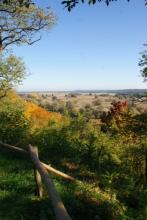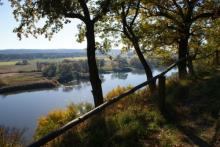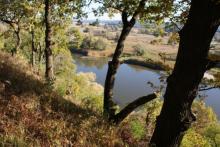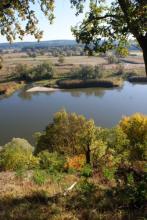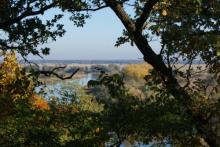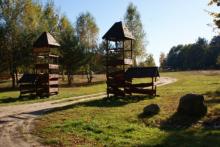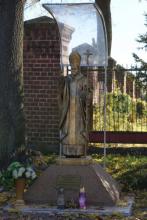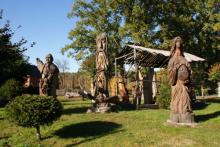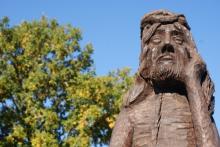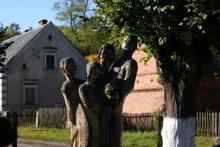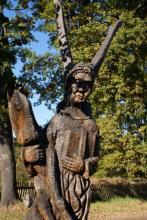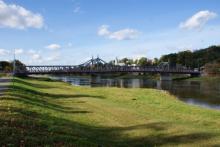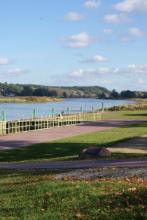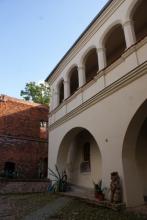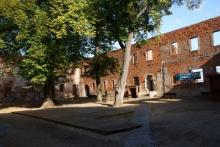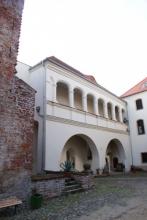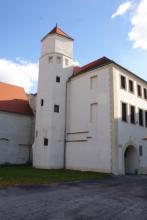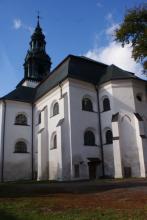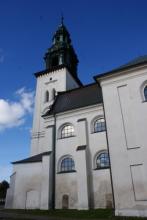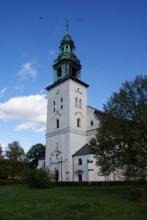Lubusz Nordic Walking Trails – Cultural trail through the centuries – Krosno Odrzańskie and the surroundings
Odra River Trail RED TRAIL
Route: Piast Castle in Krosno – Marcinowice – Osiecznica – Krosno
Route type: scenic and historical
Difficulty level: easy
Walking time: 4h (14 km)
Attractions: Numerous historical attractions. The Castle of the Piast Dukes, St. Hedwig of Silesia Church, churches designed by Schinkel in Krosno and Osiecznica, the 100-year-old Beuchett Bridge over the Odra River.
The trail starts at the Castle, the centre of the old part of Krosno, and after crossing the Odra River it makes a loop around the western part of Krosno and Marcinowice, reaching Osiecznica. It abounds in high class monuments.
Krosno Odrzańskie
The first written mention of the town dates back to 1005. The city was described in a chronicle by Bishop Thietmar of Merseburg, a participant of the expedition of the Emperor Henry II against Bolesław Chrobry. However, there are also those who, according to the latest scientific discoveries, suspect that Krosno, known to the Romans as Lugidunum, was the ancient capital of the Lugian Union, a tribal federation forming one of the two great states of antiquity on the territory of present-day Roman Poland. On the pages of history, already as a certainty, it reappears as a strategically important town of the Piast state. The town was located on an island, which proves its Slavic origin, and even, as it is believed, on many islands. Until 1482 it belonged to the Duchy of Głogów, later it was ruled by Brandenburg. For centuries it was inhabited by Slavic and Catholic people. Protestantism and the town’s incorporation into the Prussian state resulted in Germanization. The 19th century saw rapid economic development. Industrial plants were established and the town received a railway connection with Gubin and Zbąszyń. During the Second World War, the town was destroyed in 60-70%. Actress Joanna Brodzik and goalkeeper Tomasz Kuszczak were born here. Among famous people worth mentioning is Friedrich Paulus, who had his summer residence in Krosno.
Castle
The castle was built on the site of two medieval fortresses with wooden and earthen structures. Traces of buildings from the times of Duke Henry Brodaty (1163-1238), who died here, have been found. During the Tartar invasion, the castle became a shelter for the Duke’s wife – St. Hedwig of Silesia. In the following centuries it was rebuilt several times. Renaissance and Baroque elements were added. Today it is a cultural centre and houses a museum and tourist information point.
St. Hedwig’s Church
The monumental church was built on the site of a temple founded by Princess Hedwig, also known as the barefooted Duchess. This is confirmed by the earliest preserved fragments of the church from the first half of the 13th century. The late Gothic brick building was rebuilt many times. The church was subject to war damages and fires. Finally, at the beginning of the 18th century it took on a baroque style. Noteworthy in the church are baroque epitaphs and partially preserved 19th century organs.
St. Hedwig of Silesia
She was born and raised in the castle of Andechs in Bavaria. At the age of 12 she was married to Silesian Duke Henry the Bearded and gave birth to seven children. The couple were very religious people. "Since she considered the married state as a gift from heaven, she lived a very holy life. She was faithful in love to the prince until his sudden death, and not through the heat of sensual passion but through prudent heartfelt devotion," the canonization document reads. After 19 years of marriage with Henry the Bearded, they both took vows of chastity. Hedwig was the founder of churches and monasteries. She also conducted charitable activities. Among others, she opened a hospital for lepers in Środa Śląska, and established another institution in Trzebnica. There is a legend, according to which Hedwig, in order not to differ from the rest of her people, and in the name of humility and modesty, went barefoot. It irritated her confessor a lot, who ordered her to wear shoes. The princess, being obedient to her confessor, wore her shoes, but attached on a string. Today she is the patroness of German-Polish reconciliation.
Bridge on the Odra River
The picturesque bridge connecting the Odra banks was built in Zielona Góra, in the Beuchett company on the occasion of the 19th anniversary of the city. It replaced the wooden one of that time. Residents of Krosno considered it ugly and the legend says that to spite the builders, the first one to cross the bridge was a wagon with manure. However, after some time the pre-war inhabitants called it "Blaues Wunder" which means blue wonder. On some old postcard it has a blue colour. Today the bridge is considered a pearl of engineering. Beautiful especially at night in the light illumination.
St. Andrew’s Church
Behind the bridge, on the northern bank of Odra River, going in the direction of Marcinowice, we pass the picturesquely located St. Andrew’s Church from the first half of the 19th century, boasting bells from the 15th and 17th centuries. The church was designed by one of the greatest German architects of the 19th century Karl Friedrich Schinkel. It was built on the ruins of its predecessor from the 13th century.
Vineyards in Krosno and Marcinowice
The origins of grapevine cultivation in Krosno Odrzańskie date back to the second half of the 10th century. In 1154, on the initiative of Wrocław Bishop Walter of Malone, the first vineyard was planted on the so-called Bishop’s Hill and in the so-called Bishop’s Garden. The chronicles of Krosno report on the great yields and cultivated varieties that were so successful. Vines were planted in terraces on the slopes of river. Besides Krosno, grapevine was grown in Marcinowice, Osiecznica, Budachowo and Bytnica. There is a legend that Tsar Peter I, on his way to the west of Europe at the end of the 17th century, made a stop in Krosno Odrzańskie. He tasted the local wine and immediately proposed a drinking contest to the inhabitants and winemakers, which of course he won.
Krosno Odra Valley
It is a part of the Odra valley from Cigacice to the mouth of the Nysa Łużycka River. In the area there are preserved old river beds, large complexes of meadows and celery meadows as well as some fragments of ash, elm, and willow riparian forests. A considerable part of the area is flooded. The final stretch of the Bóbr River flowing into the Odra River, belonging to this protected area, is an important regional spawning ground of reophilous fish, including asp and river lamprey. The area is also important for the preservation of habitats and species associated with the great river valley, including 8 types of habitats, especially meadow complexes, and 18 species of animals under special protection living in these areas. From the route to Osiecznica the mouth of the Bóbr River to Odra can be seen.
Osiecznica
Its German name is Güntersberg. The village was mentioned in 1202 as Ossechnica. The name probably comes from the entanglements protecting the castle in Krosno. From the beginning of the 14th century there was a wooden church here. In the 15th century, the church was looked after by Dominicans from Krosno, whose representative received from Pope Benedict XIII the title of the chief inquisitor in Silesia. In the 16th century the village was bought by Günter, a townsman from Krosno. In the village there is a neo-Gothic palace from the 19th century, which was a seat of the Manteuffel family. Worth seeing is a (timbered) parish church of St. Apostles Peter and Paul built in 1816, attributed to Karol Fryderyk Schinkel. This is supported by an unsigned design of the church for "Güntersberg in Amte Crossen" preserved in the Prussian State Museum of Cultural Heritage in Berlin.
Piast Trail BLUE TRAIL
Route: Grodzisko – Gostchorze – Morsko – Grodzisko
Route type: scenic and historical
Difficulty level: easy
Walking time: 3h (10 km)
Attractions: Grodzisko in Gostchorze existed as early as the 7th century and was famous for its participation in the wars between the Brave and the Germans. From Grodzisko there is a beautiful view of the Odra valley. In Morsk there is a gallery of wooden sculptures.
The trail starts on the high bank of Odra River, in the place of the former stronghold in Gostchorze, then runs through the forests to Morsko to return to Gostchorz.
Gostchorze
Recent archaeological discoveries have confirmed that in Gostchorze in the second half of the 7th century a defensive settlement was erected, which was located on the inaccessible headland of the steep Odra river valley edge and covered an area of 40 x 100 m. The settlement was surrounded by a moat about 15 m wide. The research has shown that the stronghold of Gostchorze preceded the foundation of the Krosno stronghold by about 100 years. The written history of the castle begins with notes in the "Chronicle of Thietmar," who accompanied the army of Emperor Henry II marching in 1005 to war with Bolesław Chrobry. Thietmar describes how the Krosno strongholds repulsed the enemy attack in 1012 and 1015. The Krosno fortified settlements consisted of the settlements at Krosno, Połupin and Gostchrze. Before they became part of defensive system of the Piast state, they probably belonged to the pagan Wielets who, together with the German army, tried to regain the lost lands. They were unsuccessful, because the strongholds were not conquered. Gostchorze in 1954 for a year was Kozia Góra, because the name seemed to be German. Then the village was restored to its historical name. Legend suggests that the name is derived from the name of Prince Gostczar, who allegedly was the commander of the defense during the invasion of the Piast state by the German emperor’s army. From the high bank on which the castle is located there is a beautiful view of the Odra River and its polders.
Interesting facts
In the very centre of village, on the anniversary of the Holy Father’s death, his statue was placed. It became a kind of gift of memory from the inhabitants.
Embargo stud farm
It has been operating since 2001 as a horse riding centre and breeding Polish horse. Organizes recreational and sporting events. The owners are horse lovers. They offer: horse riding lessons, but also horse rides in the forest for organized groups. Particularly interesting is a horseback trip along an ecological nature trail. On the one and a half kilometer long route there are six stops with information about the flora and fauna of the area. It is also possible to admire glacial ponds.
Morsko, sculpture gallery
The Sculpture Gallery is located in the centre of Morsko. As it is written in the newspapers, there are more sculptures in Morsk than chimneys. Some of them reach 3.5 meters. Jan Herda, the author of sculptures, has sculpted (and still sculpts) figures of saints, Pope John Paul II, a Christmas crib and Nobel Prize winners. He came to the village from the Lublin region for an open air workshop… and stayed there. Now he organizes open-air sculptures. With the help of other sculptors he created a separate gallery of characters known from fairy tales.
"U Marychy"
The farm "U Marychy" is a small guesthouse in Gostchorz. Especially attractive for those seeking peace and escape from the city hustle and bustle. The hostess tempts guests with peace, quiet and family – homely atmosphere. The farm has five rooms, each of which has a separate bathroom and access to a kitchen.
Krosno Odra Valley
It is a part of the Odra valley from Cigacice to the mouth of the Nysa Łużycka River. In the area there are preserved old river beds, large complexes of meadows and celery meadows as well as some fragments of ash, elm, and willow riparian forests. A considerable part of the area is flooded. The final stretch of the Bóbr River flowing into the Odra River, belonging to this protected area, is an important regional spawning ground of reophilous fish, including asp and river lamprey. The area is also important for the preservation of habitats and species associated with the great river valley, including 8 types of habitats, especially meadow complexes, and 18 species of animals under special protection living in these areas. From the high bank at Gostchorz there is a view over the valley to Połupin to the south and almost to Laski to the east.
"Old Forest and Forge" GREEN TRAIL
Route: Budachów – a loop of forest paths – "Old Forest" nature reserve – Budachów
Route type: scenic and nature
Difficulty level: easy
Walking time: small loop 2h (7.5), big loop 3h (10km)
Attractions: The route leads among pine forests. On the route the "Old Forest” reserve.
The trail starts at the railway station in Budachowo, passes the old Forge and leads through meadows to the Old Forest reserve, to return to Budachowo after visiting the forester’s lodge in Łasin.
Budachów
The village has a long and mysterious history. In its area and neighborhood there are many archaeological sites, cemeteries, traces and settlement points that testify to its rich history from the Bronze Age and Lusatian culture, through the period of Roman influence and late Middle Ages to modernity. The first written reference to Budachowo comes from 1304. The village belonged to the families of von Loben and von Lessing. The register of historical monuments also includes Budachów’s spatial layout (oval village).
Church
St. Joseph Church in Budachowo was built between 1782 and 1784. It is a rectangular, brick, one-nave building. The decor is baroque, classical altar from the 18th century in the shape of a niche with canopy, on the sides there are two profiled pillars passing into the pilaster with a head in the shape of a snail, the canopy is topped with a cross, in the niche there is a sculpture of St. Joseph holding the baby Jesus.
Other monuments
There used to be a palace in the village, but it was destroyed during the war. The park established at the end of the 18th century as a landscape park with rich tree stand including heart-shaped magnolias, ash-leaved maples and white-streaked maples remains. Moreover, in Budachowo there is an old smithy under legal protection, built in the middle of the 19th century, one-storey, brick, with a high roof. There used to be a wine house in the village, which proves rich wine tradition, but it was moved in 1979 to the Ethnographic Museum in Ochla near Zielona Góra where it is a great attraction. In the middle of the 19th century a railroad line between Czerwinsk and Rzepin was constructed and the station in Budachow is still in operation.
"Old Forest" Reserve
Not far from the Łasiczyn settlement there is a nature reserve "Old Forest.” In the reserve there are 11 monumental trees, among others: 550-year-old Querkus robur, with a circumference in the so-called breast height diameter (at a height of 1.5 m) of 6.70 m and a height of 25 m. There is also a magnificent 300-year-old beech with a breast height circumference of 3.30 m and a group of 200-year-old pine trees.
Forester’s lodge Łasiczyn
There is an agritouristic farm in the forester’s lodge Łasiczyn. By the forest lodge, 100-year-old vines wrap around the pergola, under which there is an oak feasting table. According to the hosts, guests like to listen to the sounds of forest, which speaks with the singing of birds, autumn roaring of deer and sometimes howling wolves. Occasionally guests will go or ride bicycles on a trip into the wilderness to follow the tracks of wolves and other forest inhabitants. The forester’s lodge offers a homely atmosphere and family-like conditions, including old Polish cuisine and its own wine.
Localization:
The public task is co-financed from the funds received from the Marshal's Office of the Lubuskie Voivodeship



